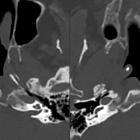eustachian tube












The Eustachian tube, also known as the pharyngotympanic tube or auditory tube, is the channel via which the tympanic cavity communicates with the nasopharynx.
Gross anatomy
It is ~36 mm in length and is directed downward, forward, and medially, forming an angle of about 45 degrees with the sagittal plane and one of 30 to 40 degrees with the horizontal plane.
It consists of osseous and cartilaginous/fibrous tissue portions.
Osseous portion
The bony (osseous) portion has a length of approximately 12 mm. It starts in the carotid wall of the tympanic cavity, below the tensor tympani muscle, and gradually narrows, ending at the angle formed by the junction of squamous and petrous portions of the temporal bone. The edge of the osseous portion has a jagged margin which allows for the attachment of the cartilaginous portion.
Cartilaginous portion
The cartilaginous portion is approximately 24 mm long and consists of a triangular plate of elastic fibrocartilage, the apex of which is attached to the margin of the medial end of the osseous portion of the tube, while its base lies directly under the mucous membrane of the nasopharynx, where it forms an elevation, the torus tubarius or cushion, behind the pharyngeal orifice of the tube. The upper edge of the cartilage is curled upon itself, being bent laterally causing a hook-like appearance on cross-sectional images; a groove or furrow is thus produced, which is open below and laterally, and this part of the canal is completed by a fibrous membrane. The cartilage lies in a groove between the petrous part of the temporal bone and the great wing of the sphenoid bone; this groove ends opposite the center of the medial pterygoid plate.
The cartilaginous and osseous portions of the tube are not in the same plane, the former inclining a little more downward than the latter.
The diameter of the tube is not uniform throughout, being greatest at the pharyngeal orifice, least at the junction of the bony and cartilaginous portions, and again increased toward the tympanic cavity; the narrowest part of the tube is termed the isthmus.
Mucous membrane
The mucous membrane of the tube is continuous in front with that of the nasopharynx, and behind with that of the tympanic cavity. It is covered with ciliated epithelium and is thin in the osseous portion, while in the cartilaginous portion it contains many mucous glands and near the pharyngeal orifice a considerable amount of adenoid tissue.
Attachments
- tensor veli palatini muscle
- levator veli palatini muscle
- salpingopharyngeus muscle
- tensor tympani muscle
During swallowing, the tensor veli palatini and levator veli palatini act (laterally and medially, respectively) to open the cartilaginous portion of the Eustachian tube.
Arterial supply
Venous drainage
Lymphatic drainage
Innervation
- osseous portion supplied by the tympanic plexus
- cartilaginous portion supplied by the pharyngeal branch of the pterygopalatine ganglion and the meningeal branch of the mandibular nerve
History and etymology
The Eustachian tube is named after the Italian physician Bartolomeo Eustachio (1514-1564).
Related pathology
- patulous tube syndrome
- Eustachian tube dysfunction
- Eustachian tube cyst
Siehe auch:
- Torus tubarius
- Verkalkungen Tuba auditiva Eustachii
- middle ear effusion
- eustachian tube dysfunction
- Rosenmüller-Grube
- Klaffende Tuba auditiva Eustachii
- Tubensprengung
- Tubenkatarrh
- Politzer-Ballon
und weiter:

 Assoziationen und Differentialdiagnosen zu Tuba auditiva Eustachii:
Assoziationen und Differentialdiagnosen zu Tuba auditiva Eustachii:
